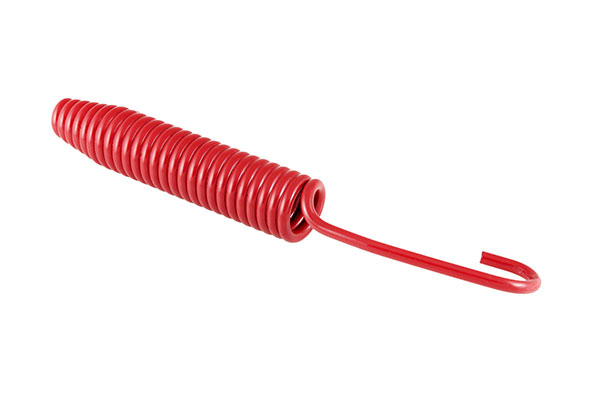Conical Extension Springs

Need a quote for conical extension springs? Click here to get one today.
Conical Extension Springs are best suited for heavy duty or high cycle applications. The hooks can be designed for extended life as compared to standard extension springs of similar dimension. The hooks are also free to rotate to assure alignment. (Sometimes can be considered heavy duty extension springs)
Conical Extension Springs or Conical End Reduced Extension Springs are made by coiling two or three or possibly four coils gradually smaller in diameter and then forming the hook on the smallest reduced coil. The hook may be a regular hok, a crossover hook, or a half hook to suite the requirements. This method is the easiest way to reduce the hook stresses and retard breakage. The reason for longer life is that the bending moment is lessened, thereby reducing the stress and making the hook last longer.
Conical extension end require a method of attachment to other parts in an assembly. A wide variety of ends are available for a conical extension spring including threaded insert, swivel hooks, twist loops, side loops, cross-center and extension hooks. The most common configurations can be made during the manufacture of conical extension springs.
Ace Wire Spring & Form provides a wide variety of custom and precision conical extension springs and heavy duty extension springs to meet your specifications and exceed your expectations.
Design & Specs
In Ordering Conical Extension Springs Give the Following Information as Completely as Possible:
- Length, Maximum, Minimum, (Over all, Over coil, Inside Hooks).
- Controlling Diameter: Outside Diameter Maximum. Inside Diameter Minimum.
- Wire Size. Decimal size if Possible. Material, Kind and Grade.
- Number of Coils.
- Style of Ends, (see illustrations). Right or Left Hand Wound.
- Finish (Plain unless otherwise specified).
- Load Required, Length Inside Hooks (Length of Coil if wire size not specified).
- Maximum Extended Length (Over all, Over coil, Inside Hooks).
- Deflection or Distance of Travel. Frequency of Extension.
- Is Position of Ends important? (Making the ends of springs bear a definite relation to each other usually adds to the cost of manufacture.)
Note: Conical Extension springs made from tempered or hard-drawn wires can be and usually are wound with initial tension. Such tension may average 20% of the total safe stress of the springs, but will not increase the elastic limit.
Conical Extension Spring Ends
The variety of ends that can be put on coned extension springs is limited only by the imagination and may include threaded inserts, reduced and expanded eyes on the side or in the center of the spring, extended loops, hooks or eyes at varying positions or distances from the body of the spring, and even rectangular or tear drop shaped ends. (The end is a loop when the opening is less than one wire size; the end is a hook when the opening is greater than one wire size.) By far the most common, however, are the machine loop and crossover loop. These ends are made with standard tools in one operation and should be included in extension spring specifications whenever possible to minimize cost.
It should be remembered that as the space occupied by the machine loop is shortened, the transition radius is reduced and an appreciable stress concentration occurs. This contributes greatly to shortening spring life and premature failure.
Most coned extension spring failures occur in the area of the end. To maximize the life of the spring, the path of the wire should be smooth and gradual as it flows into the end. Tool marks and other stress concentrations should be held to a minimum. A minimum bend radius of 1 1/2 times the wire diameter is recommended.
In the past, many ends were made as a secondary operation. Today, with modern mechanical and computer controlled machines, many ends can be made as part of the coiling operation. Due to the large variety of machines available for coiling and looping in one operation, it is recommended that the spring manufacturer be consulted before a design is concluded.
Conical Extension Springs Design Method
The fundamental formulas involving load/deflection (rate) and stress also apply to helical extension springs. The only unique property is that a solving for and including initial tension in the concept and method. Given a certain volume of space in which the spring will act and a certain maximum load (P) the basic design approach is to find a wire diameter (d) based on trial value of mean diameter (D) assumed on the basis of the available space, and a reasonable stress (S). Remember that an extension spring is not normally present and must be designed within torsion proportional limit of the material. This value will be about 40 percent of the tensile strength of the material.
After a wire size is determined, establish the load deflection relationship and find out if the wire size picked will allow the spring to fit in the volume of space available. Involved in this decision is the solution for rate, number of coils and initial tension. The rate is foundby the load/deflection relationship. The final step would be to determine whether the available initial tension (Pi), plus the load added by deflecting to L1, will add up to the first load required (P1).

